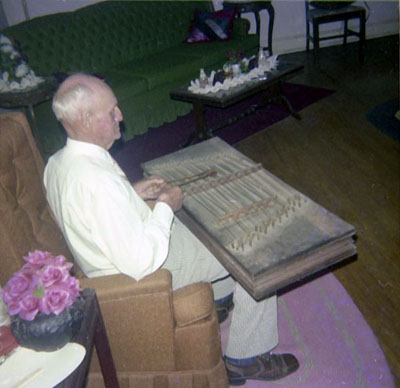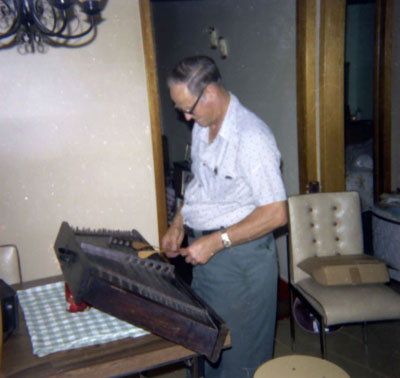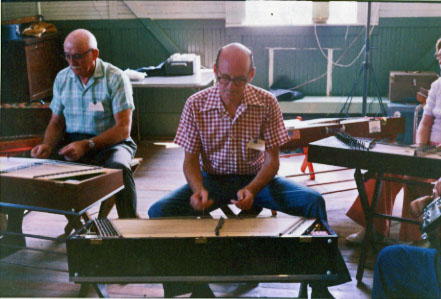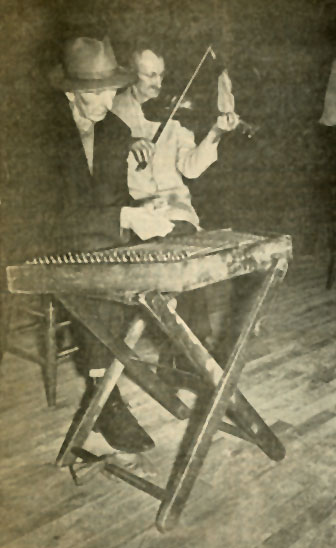DULCIMERThe dulcimer I refer to, of course, is the hammered dulcimer. This page is intended to bring together separate webpages consisting of text, illustrations, and recordings and to maintain them at a hierarchical level equivalent to the personal, fiddle, and songs pages. This instrument was one of the earliest instruments to be manufactured on a large scale in the United States. Three factories were in operation in Sherman and Stedman, Chautauqua County, New York (my father's hometown) before the Civil War, producing thousands. It was a staple instrument in early Michigan. The following exhibited their dulcimers at various early county fairs in Michigan: Nathaniel T. Waterman, Branch County (1854); Mr. Bennett, Branch County (1855); Ezra Durand, Berrien County (1856); Lewis Sage, Macomb County (1856); Mortimer DeLano, Oakland County (1857). Durand had a colorful career in various parts of the United States, and DeLano sold a large number. I don't know anything about the others, but, since few dulcimers were marked with their makers' names, it is likely that their instruments may welll be found today. The commercial activity of these and other makers and manufacturers were responsible for the spread of the dulcimer throughout the country, especially in rural areas of the newly settled Midwest and Upper South. But migration during this period seems to have been a strong influence as well. The details remain lost, but it certainly seems that by 1830 or 1840, Western New York must have witnessed an increase in popularity of this instrument. Manufacture had begun by 1848, when C. Haight published his Complete System for the Dulcimer (New York: William Hall, 1848). Migration out of western New York during this period was largely across Lake Erie to Michigan (as well as northern Ohio) or further west to Wisconsin, northern Illinois, and northwestern Indiana. In 1860, Michigan had the largest New York-born population outside of New York itself, with over 191,000 people. Illinois and Wisconsin followed, with 125,000 and 122,000 respectively. Migrants from the Empire State also comprised the principal source of the population in Michigan (in 1850, more were born in New York than in Michigan itself) and in the northern tier of counties in Ohio, in northwestern Indiana, in northern Illinois, much of Wisconsin, and further west into Iowa. Thus it is no accident that the particular variety of English (called "Inland Northern" by linguists) is virtually the same between Syracuse, New York, and Cedar Rapids, Iowa. The instrument also had a certain popularity outside this region. One was northern West Virginia, including Doddridge, Harrison, and Marion Counties, and another was around Randolph, Forsyth, and Moore Counties, North Carolina. A manufacturer active in Sedalia, Missouri, in the 1870s sold many in that area. Another manufacturer, originally from Michigan, went to Connecticut in the 1860s and sold instruments in New England, and another Michigander went to Vermont, Illinois, and popularized the instrument in western Illinois. A number of players lived in Texas, in Utah, and in the Pacific Northwest, as well as in central Indiana, Illinois, and Missouri, and it had a certain popularity in Middle Tennessee. There was also a fashion for the instrument in the New York City region at the turn of the 20th century. Except for the New York City fashion, which, as an urban style, seems to have been more associated with that of contemporary fretted instruments, these dulcimer players were rural and played what would be described as "old-time" music. Many played informally with other instruments. But solo playing seems to have been more typical than in the "Inland North," where the dulcimer was often considered a "seconding" instrument. The early-20th-century players in the North I used to hear of would typically play the fiddle or other instruments as well as the dulcimer, and might be part of a family where different members, such as two brothers, or father and daughter, would play together. The playing might be for personal entertainment at home in the evening, but it might also provide music for dancing at local parties or perhaps in rural halls. The dulcimer recordings I include on the linked pages include some from Volga German and Scottish tradition as well as American and Canadian tradition. However, since the "Great Lakes Region" tradition associated with accompanying fiddling is still largely unknown, decades after a major revival of the instrument, I am trying to focus on that in these pages. Nevertheless, recordings of solo playing deserve attention, and I am appending those on this page.
Recordings
1. Durang's Hornpipe played by Archie Barnes, dulcimer. Recorded by Charles Delamarter for the Okemos Historical Society, Okemos, Michigan, September 1964. 2. Moonglow Schottische played by Archie Barnes, dulcimer. Originally recorded on disc in 1957; recorded by Charles Delamarter for the Okemos Historical Society, Okemos, Michigan, September 1964. 3. Peek-a-Boo Waltz played by Archie Barnes, dulcimer. Recorded by Charles Delamarter for the Okemos Historical Society, Okemos, Michigan, September 1964.
4. Blind Child played and sung by J. R. (Peanut) Cantrell, dulcimer, McMinnville, Tennessee, September 21, 1975. 5. Sail Away Ladies played by J. R. (Peanut) Cantrell, dulcimer, McMinnville, Tennessee, September 21, 1975. 6. Susie, Won't You Come? played by J. R. (Peanut) Cantrell, dulcimer, McMinnville, Tennessee, September 21, 1975.
7. Unnamed tune played by Ted Delorme, dulcimer, accompanied by Paul Gifford, guitar, North Bay, Ontario, Canada, September 6, 1979. 8. Unnamed tune whistled by Ted Delorme to his own dulcimer accompaniment, North Bay, Ontario, Canada, September 6, 1979. 9. Unnamed tune played by Ted Delorme, dulcimer, accompanied by Paul Gifford, guitar, North Bay, Ontario, Canada, September 6, 1979.
10. Cuckoo's Nest played by Worley Gardner and Willis Gardner, dulcimers, accompanied by unknown, guitar, at Mountaineer Dulcimer Funvention, Mannington, West Virginia, July 1, 1973. 11. Leather Breeches played by Worley Gardner and Willis Gardner, dulcimers, accompanied by unknown, guitar, at Mountaineer Dulcimer Funvention, Mannington, West Virginia, July 1, 1973.
12. Do-Si Balinet played by Chet Parker, dulcimer, at home in Edgerton, Michigan, August 8, 1971. 13. Leather Breeches played by Chet Parker, dulcimer, accompanied probably by Warren (Killer) Waid, electric guitar. Recorded by Jim Herald at Driftwood Inn, Croton, Michigan, about 1969. 14. Pacific Quadrille: 2nd Change played by Chet Parker, dulcimer, accompanied probably by Warren (Killer) Waid, electric guitar. Recorded by Jim Herald at Driftwood Inn, Croton, Michigan, about 1969. 15. Right and Left Six played (with calling) by Chet Parker, dulcimer, Edgerton, Michigan, August 8, 1971. Les Raber also played a version of this tune that he associated with this call. 16. Unnamed tune in 6/8 played by Frank Stevens, Sand Lake, Michigan, August 8, 1971. See Unnamed tune ("Worcester Oddity") played by Frank Mattison, Varsal Fales, and others for other versions. 17. Unnamed tune in 2/4 played by Paul Van Arsdale, dulcimer, accompanied by Bill Van Arsdale, guitar, at family reunion, Fredonia, New York, July 1975. He learned all these three tunes from his grandfather, Jesse R. Martin. 18. Unnamed tune in 2/4 played by Paul Van Arsdale, dulcimer, at family reunion, Fredonia, New York, July 1975. 19. Liverpool Hornpipe played by Paul Van Arsdale, dulcimer, and Phillip Van Arsdale, dulcimer (but barely audible), accompanied by Bill Van Arsdale, guitar, at family reunion, Fredonia, New York, July 1975. 20. Jumping Toothache played by Fenton Watkins, dulcimer, at Birmingham, Michigan, March 1976. Watkins was also a fiddler, although I never heard him play the violin. He played a number of the same tunes on the dulcimer that he played on the fiddle, and I think this was one of them. Merritt Olsen learned his version of this tune, and it was in the key of C. 21. Merle Barner played by Fenton Watkins, dulcimer, accompanied by Paul Gifford, guitar, at Birmingham, Michigan, March 1976. This is a nameless tune he learned from Merle Barner, and his way of identifying it in a list of tunes he played was to call it by this name. 22. Old Rittenhouse played by Fenton Watkins, dulcimer, at Birmingham, Michigan, March 1976. He explains that when he was a boy, near South Haven, there was a fiddler named George Rittenhouse who wrote a tune that mocked another local fiddler, Een Glaspie. Glaspie then followed suit by writing a tune and song that made fun of Rittenhouse. 23. Hound Over the Mountain played by Sterl Van Arsdale,dulcimer, Fredonia, New York, July 1975. This tune was once played by fiddlers in the hills of northern Pennsylvania.
|
||||
|



